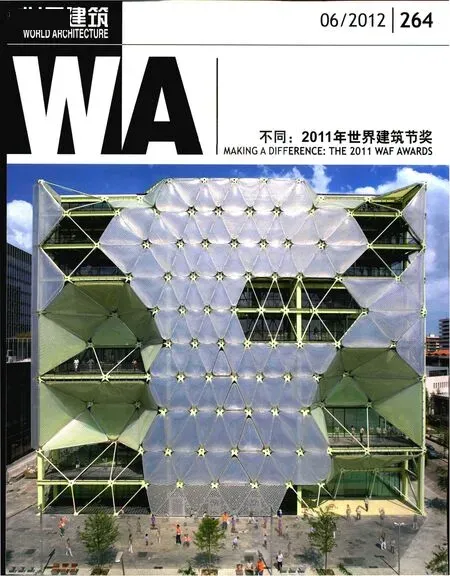圣尼古拉斯教堂,斯普林代尔,阿肯色州,美国
2012-04-09建筑设计马龙布莱克韦尔建筑师事务所
建筑设计:马龙·布莱克韦尔建筑师事务所
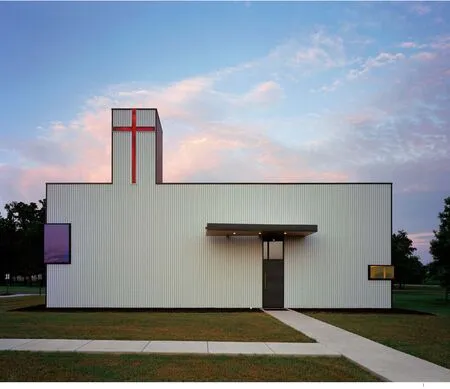
1 外景/Exterior view(摄影/Photo: Timothy Hursley)
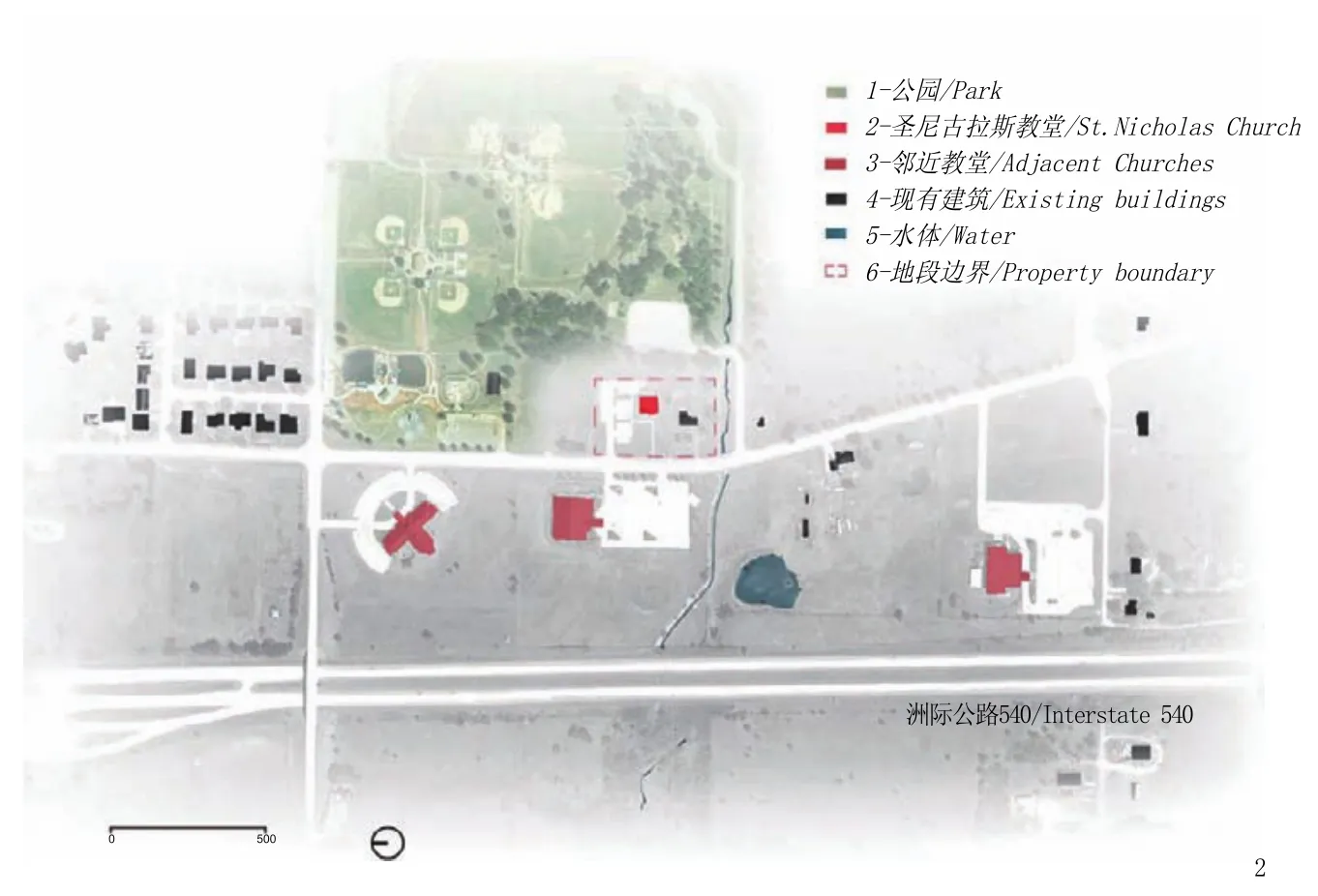
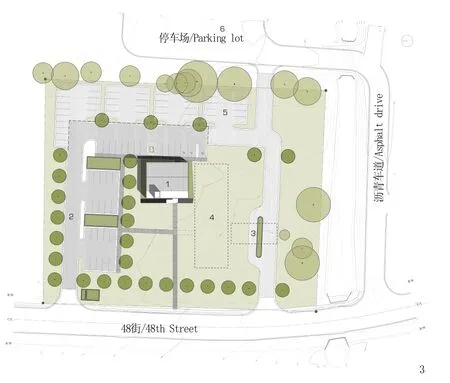
2 地段位置图/Site location
3 总平面/Site plan 1-教堂/Church 2-停车/Parking 3-现有建筑/Existing house 4-待建圣殿/Future sanctuary 5-待建停车/Future Parking 6-公共停车/Public grounds Parking
经过长时间的资金募集,圣尼古拉斯东正教堂选址在阿肯色州斯普林代尔的一处1.2万m2(3英亩)的土地上,东与一个大型公园相邻,西面接近主干道。在对地段上现有房屋和钢结构商店建筑的优点进行长时间讨论后,方案决定把商店建筑重新改造成新的礼拜空间。现有的商店建筑有3个可升起的车库门、一个用于储存的小夹层和一间办公室。夹层和办公室被完全拆除,西立面也做了改动,以容纳一个更大的夹层,并将整个西立面加长了0.254m(10英寸)。钢框架位于建筑中唯一一处可以引入礼拜堂入口的塔的元素的地方。建筑物被由箱肋金属板和彩色玻璃组合成的新表皮包裹着——模糊并改善了原来的山墙造型。虽然建筑很小,但从附近的公路上看去,它强有力的形式、表皮和象征符号使其无论在白天、黑夜都能突显出来。
虽然传统的东正教堂是轴向东西的,这个矩形的商店建筑却是南北向的。尽管礼拜仪式的规定是,若礼拜空间没能够面向东方就应该“调整方向”,但这个项目是通过折叠的手段使建筑拥有正确的方向。教堂前厅没有遵照传统的轴向序列,而是沿圣殿空间的轴线转折90°,这样,教民一进入圣殿就会体验到东西向的轴线感。这一微妙的调整使为满足功能要求的改建最小化,白橡木制成的长条悬挑木构件强化了点燃祷告蜡烛的仪式和前往朝拜之路的庄严感。当人们经过烛光摇曳中的教堂前廊,在橡木地板之上的天花板逐渐降低形成压抑感,之后则会到达作为东向圣殿空间入口的天光塔。这个塔由天窗采光,其中一个红色玻璃的十字架面朝西方,每天早晨有东方初阳从它背后投射,夜间则通过人工照明,使人们从附近高速路上都可以遥遥看见它的影像。
在圣殿东端,天花板打开一部分以留出9.14m(30英尺)宽的半透明玻璃气窗,使圣殿在清晨祷告仪式时得以沐浴在柔和的阳光中。圣障(即在圣殿和代表天地分界的祭坛区之间的分隔墙)的刻画精美,上面有表示天堂和人间分界的手绘漆像和金像。圣障中有两个隐藏的可开启面板,牧师可以在主持礼拜仪式时穿过。圣殿还有一个突起的圆顶,由一个圆盘式天线接收器改造而成,倒转、抹灰后刻上耶稣像,基督的形象就在这里出现。
圣殿的橡木地板和穹顶反映了一种设计策略,教堂室内的竖向表面经过简洁处理的彩色光线照亮。与此形成对比的是,拥有不同层级的水平面更具表现力。在集会厅中,原先金属质感商店建筑的混凝土板和屋顶结构被暴露出来。暴露的隔离层和钢结构全被漆成黑色,原来商店的灯具被移至集会厅中照明。和集会厅相连的是包括厨房和卫生间的一些新的服务设施,上面的夹层容纳了一个大型多功能空间和约翰神父的办公室,从那里可以俯瞰教堂的前厅。
虽然这里平时仅接待80个人左右,在假期中则有两倍之多。圣殿的一面墙上有两部分可以对集会厅敞开,在假期中,这些可控的墙体能使圣殿与集会大厅联通,以容纳多出的人员。这种灵活性的设置体现出预算的限制和设计所需的智慧。
自从新的礼拜空间开放后,集会量已经增长了30%,使人们开始期待在这里实现一个可容纳200名信徒的大型圣殿。总平面中已经考虑了未来的发展,采用了敏感的停车策略,与典型的在街道和建筑之间的宽带停车相反,把停车场布置在了教堂的侧面和后面。同时形成了一个大的广场,新的圣殿空间最终将限定广场的南边界。现在,白色的建筑立面成为了教堂的一块布告板,它的外形从高速路上清晰可辨。这个小教堂尽管被很多更大的教堂包围着,却有着非凡的姿态。□(厉奇宇 译)
After a lengthy search for property, the congregation of Saint Nicholas Eastern Orthodox Church found a three acre site in Springdale,Arkansas, bordered to the east by a large public park and exposed to a major highway to the west.After a lengthy debate about the merits of the existing house and steel-framed shop building, the decision was made to repurpose the shop building into a new worship space. The existing shop building had three high lift garage doors, a small mezzanine for storage, and an office. The mezzanine and the office were completely removed, as was the western facade to allow for a larger mezzanine and a ten foot wide addition across the entire length of the west elevation. The steel frame was in only one location to allow for the introduction of a tower element that highlights the entry to the sanctuary.The building is enveloped by a new skin of boxribbed metal panels and colored glass openings:the original gabled form is obscured and refined.Although a small structure, its bold form, surface and symbols make it recognizable both day and night from the nearby interstate.
While traditional Eastern Orthodox Churches are axial and face east, the rectangular shop building was oriented north-south. Although there are liturgical provisions for "reorienting" a worship space that is unable to face east, the program was simply folded to allow for the proper orientation.Rather that adhering to the traditional axial progression, the narthex is folded 90 degrees to the axis of the sanctuary space so that parishioners are delivered to the east-west axis once they arrive in the sanctuary. This subtle compromise allows for a very minimal addition in order to accommodate the program, dignified by a long suspended piece of millwork made of local white oak that embraces the ritual of lighting prayer candles and paying respect to saints en route to worship. As one passes through the candle-lit narthex, the ceiling gradually descends above a floor of oak, compressing the visitor before passing under the sky-lit tower that marks the entry into the sanctuary oriented to the east. The tower is lit by a skylight and houses a cross facing west filled with red glass, backlit by the eastern sun each morning and artificially illuminated at night to be visible from the adjacent highway.
At the east end of the sanctuary, the ceiling is carved away to allow for a 30 foot wide transom of translucent glass that bathes the sanctuary in soft light for morning services. The iconostasis,the screen wall between the sanctuary and the altar area representing the separation between heaven and earth, is the one vertical surface that is articulated in great detail. It features hand-painted and gilded icons representative of the separation of heaven and earth. Two hidden operable panels in the iconostasis allow for the priest to pass through while performing rituals according to the church's liturgy. The sanctuary also features a dome,fashioned from a repurposed satellite dish, inverted and plastered, then inscribed with the image of the"pantocrator," the image of Christ rising as the sun in the east.
The oak floor and the dome of the sanctuary reflect a strategy in which the interior vertical surfaces of the church are bathed in light with color accents with limited articulation. In contrast,the horizontal surfaces are expressive, revealing priorities and hierarchies. In the fellowship hall,the original concrete slab and the roof structure of the metal shop building are exposed, revealing the origins of the building. The exposed insulation and steel structure were simply painted black while the original shop lights were relocated to illuminate the fellowship hall. Adjacent to the fellowship hall are new services, including restrooms and a kitchen,while the mezzanine above houses a large multipurpose space and Father John's office, which overlooks the narthex.
Although regular services draw approximately 80 visitors, holiday services draw twice as many.Rather than design the sanctuary for the greater number, one wall of the sanctuary has two large sections that swing open to the fellowship hall.These operable walls stow completely allowing for the fellowship hall to be used for overflow seating during holiday services. This flexibility allows reflects the modest budget and resourcefulness required of the design.
The congregation has grown by 30% since the new worship space has opened, fostering the dream of a larger sanctuary to be located on the same site to house 200 worshipers. The site plan was developed with the future phase in mind, employing a sensitive parking strategy, one that kept parking to the side and rear of the church, contrary to the typical practice of wide bands of parking between the street and the building. Instead, a large "plaza"is formed which will eventually be framed to the south by the new sanctuary space. For now, the graphic white elevation serves as a billboard for the church, its profile easily seen and identified from the highway. It is a small church with a large presence despite being surrounded by numerous larger churches.□(图片提供/Images courtesy:Marlon Blackwell Architect)
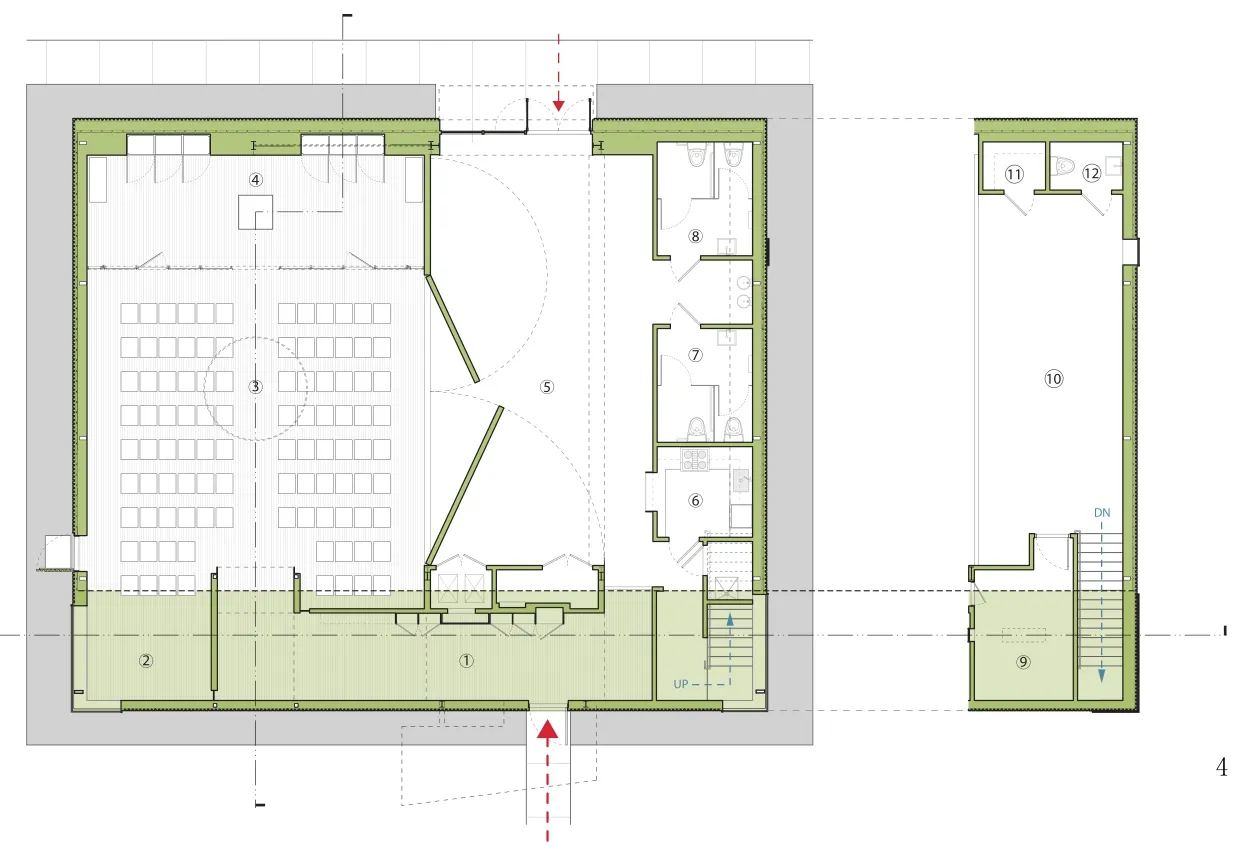
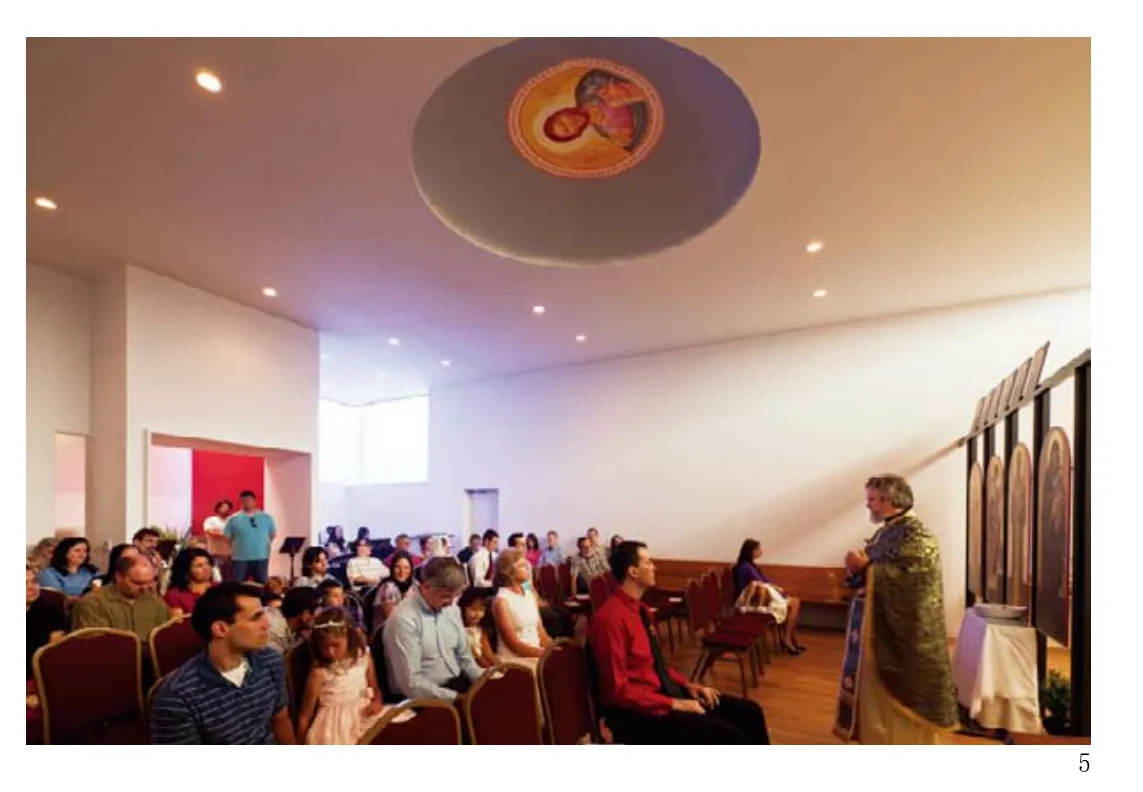
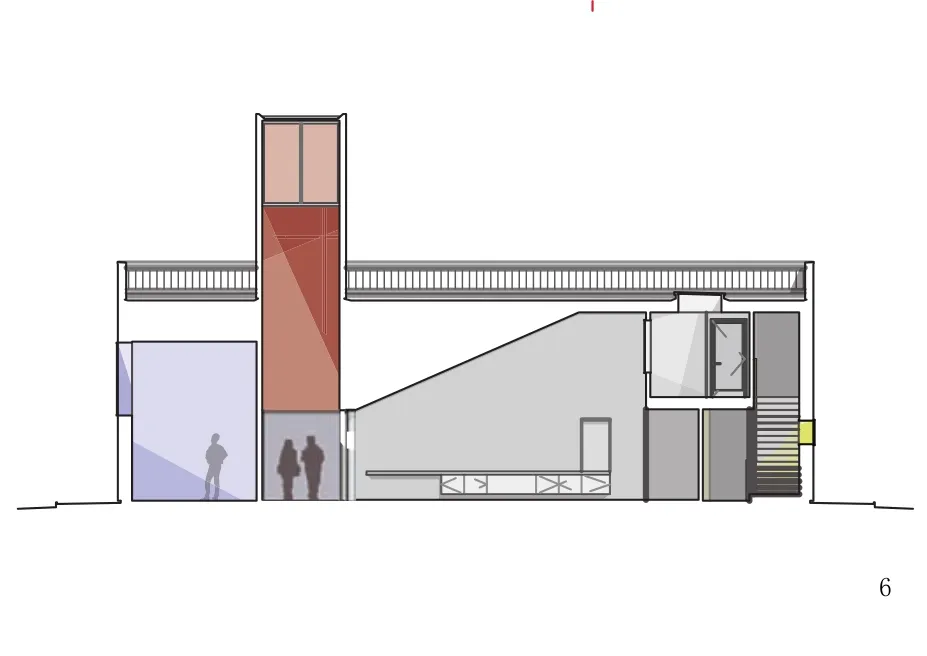
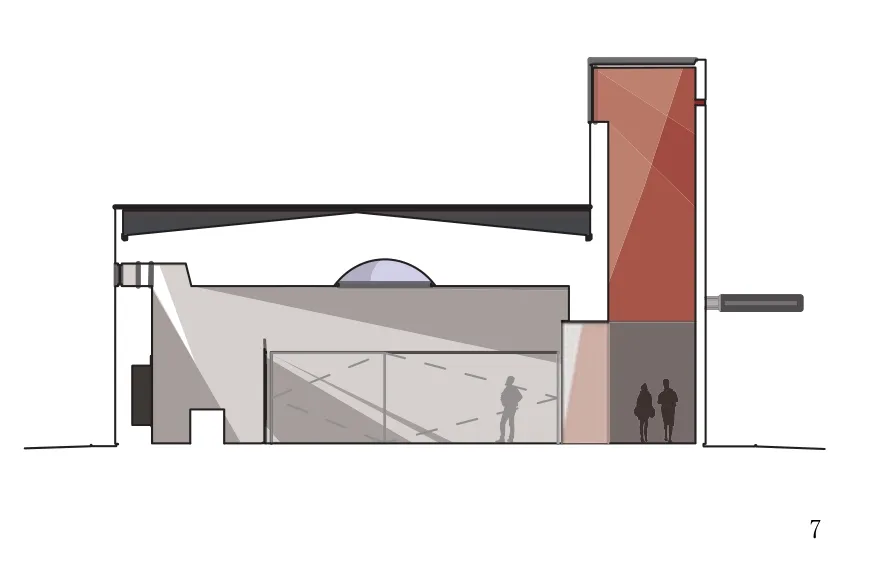
4 平面/Plan 1-教堂前厅/Narthex 2-唱诗班席位/Choir 3-圣殿/Sanctuary 4-圣坛区/Altar area 5-集会厅/Fellowship hall 6-厨房/Kitchen 7-男卫生间/Men’s room 8-女卫生间/Women’s room 9-办公室/Office 10-夹层/Mezzanine 11-储藏间/Storage 12-卫生间/Restroom
5 内景/Interior view(摄影/Photo: Timothy Hursley)
6.7 剖面/Sections
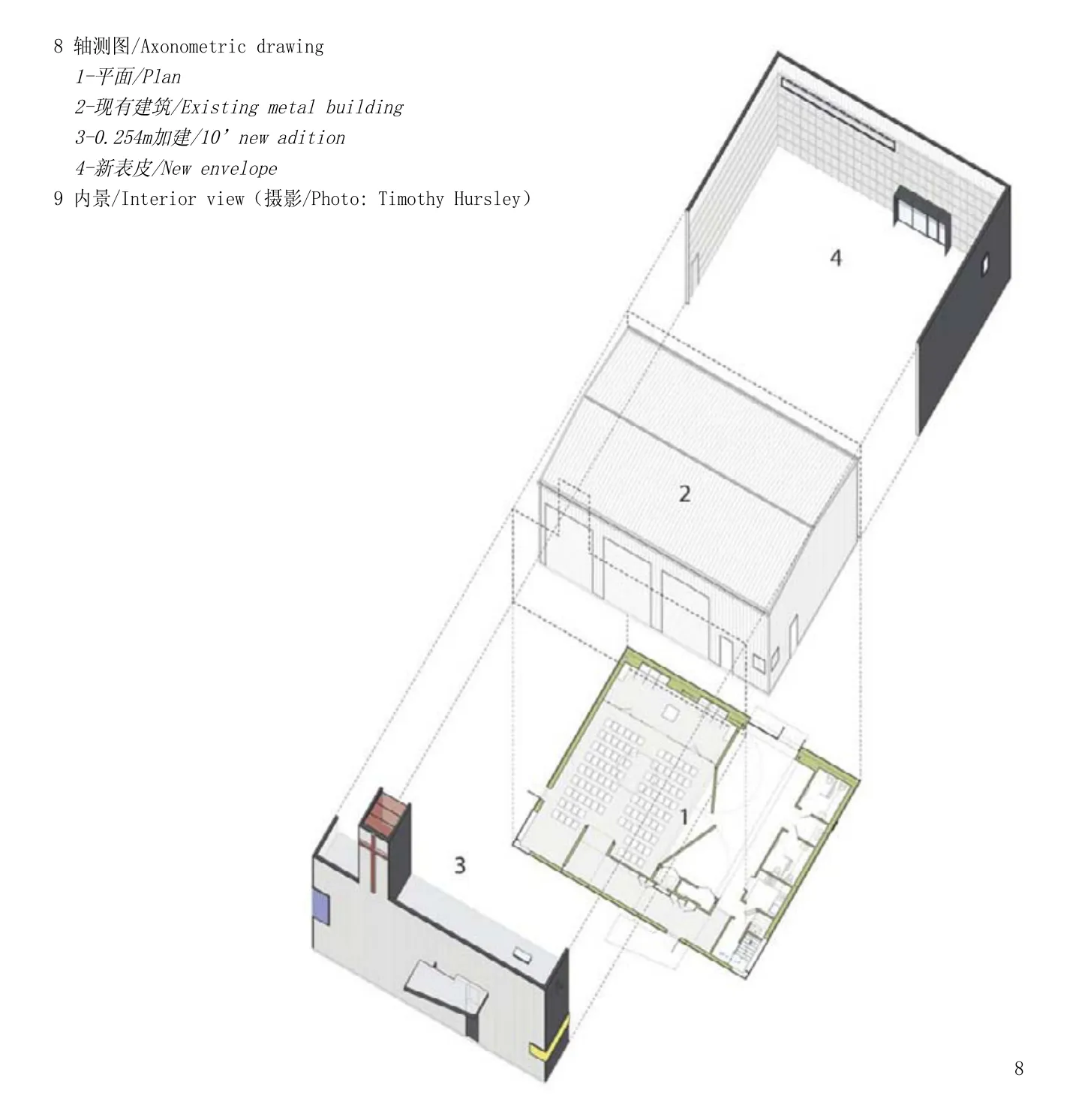
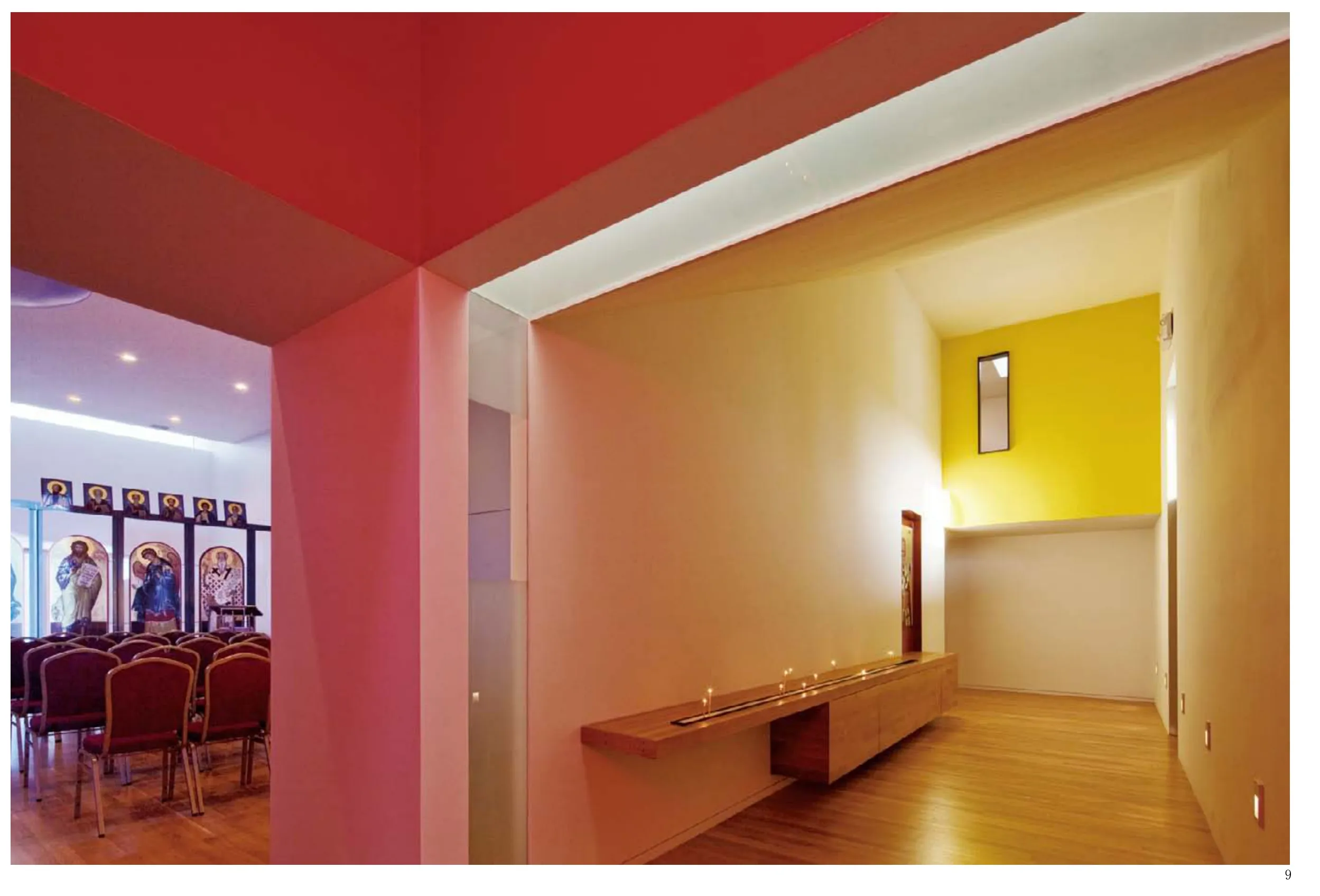
业主/客户/Owner/Client: 圣尼古拉斯东正教堂/Saint Nicholas Eastern Orthodox Church
项目团队/Project Team: Marlon Blackwell, FAIA[principal], Jon Boelkins, Bradford Payne, Gail Shepherd, Meryati Johari Blackwell, Stephen Reyenga
市政工程/Civil: Bates & Associates, Inc
结构工程/Structural: Myers Beatty Engineering, Inc承建商/Contractor: Lourie Construction LLC
所获奖项/Award: 2011年世界建筑节市民社区建筑奖/2011 WAF-Civic and Community Winner
评语
这一类别是最强的类别之一,有4、5个出色的项目。值得一提的是,本项目的设计者真正使建筑从无到有——项目得到了充分地发展,并确实满足了私密和公共的成分。
Jury Citation
This section was one of the strongest sections with four or five outstanding projects. It is really important to make the point that the designers on this project really made architecture out of nothing-the project was fully developed and really fulfilled the private and public component.
